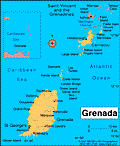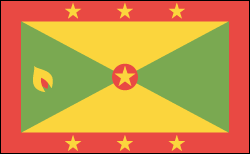GeographyGrenada (the first “a” is a long vowel) is the most southerly of the Windward Islands, about 100 mi (161 km) from the Venezuelan coast. It is a volcanic island traversed by a mountain range, the highest peak of which is Mount St. Catherine (2,756 ft; 840 m). GovernmentConstitutional monarchy. A governor-general represents the sovereign, Elizabeth II. HistoryThe Arawak Indians were the first to inhabit Grenada, but they were all eventually massacred by the Carib Indians. When Columbus arrived in 1498, he encountered the Caribs, who continued to rule over the island for another 150 years. The French gained control of the island in 1672 and held on to it until 1762, when the British invaded. Black slaves were granted freedom in 1833. After more than 200 years of British rule, most recently as part of the West Indies Associated States, Grenada became independent on Feb. 7, 1974, with Eric M. Gairy as prime minister. In 1979, the Marxist New Jewel Movement staged a coup, and its leader, Maurice Bishop, became prime minister. Bishop, a protégé of Cuba's President Castro, was killed in a military coup on Oct. 19, 1983. U.S. Invades Cuba to Thwart Cuban MilitaryIn an effort to establish order on the island and eliminate the Cuban military presence, U.S. president Ronald Reagan ordered an invasion of Grenada on Oct. 25, 1983, involving over 1,900 U.S. troops and a small military force from Barbados, Dominica, Jamaica, St. Lucia, and St. Vincent. The troops met strong resistance from Cuban military personnel on the island but soon occupied it. After a gradual withdrawal of peacekeeping forces, a centrist coalition led by Herbert A. Blaize won a parliamentary majority in 1984. The New National Party (NNP), led by Keith C. Mitchell, won a majority in the 1995 parliamentary elections. He won reelection again in 1999 and 2003. In Sept. 2004, Grenada suffered the most damage of any country from Hurricane Ivan, which killed 39 and left thousands homeless. In July 2005, Hurricane Emily wreaked further destruction. On July 8, 2008, the National Democratic Congress won 11 of 15 seats in parliamentary elections. Tillman Thomas was sworn in as prime minister on July 9. | ||||







